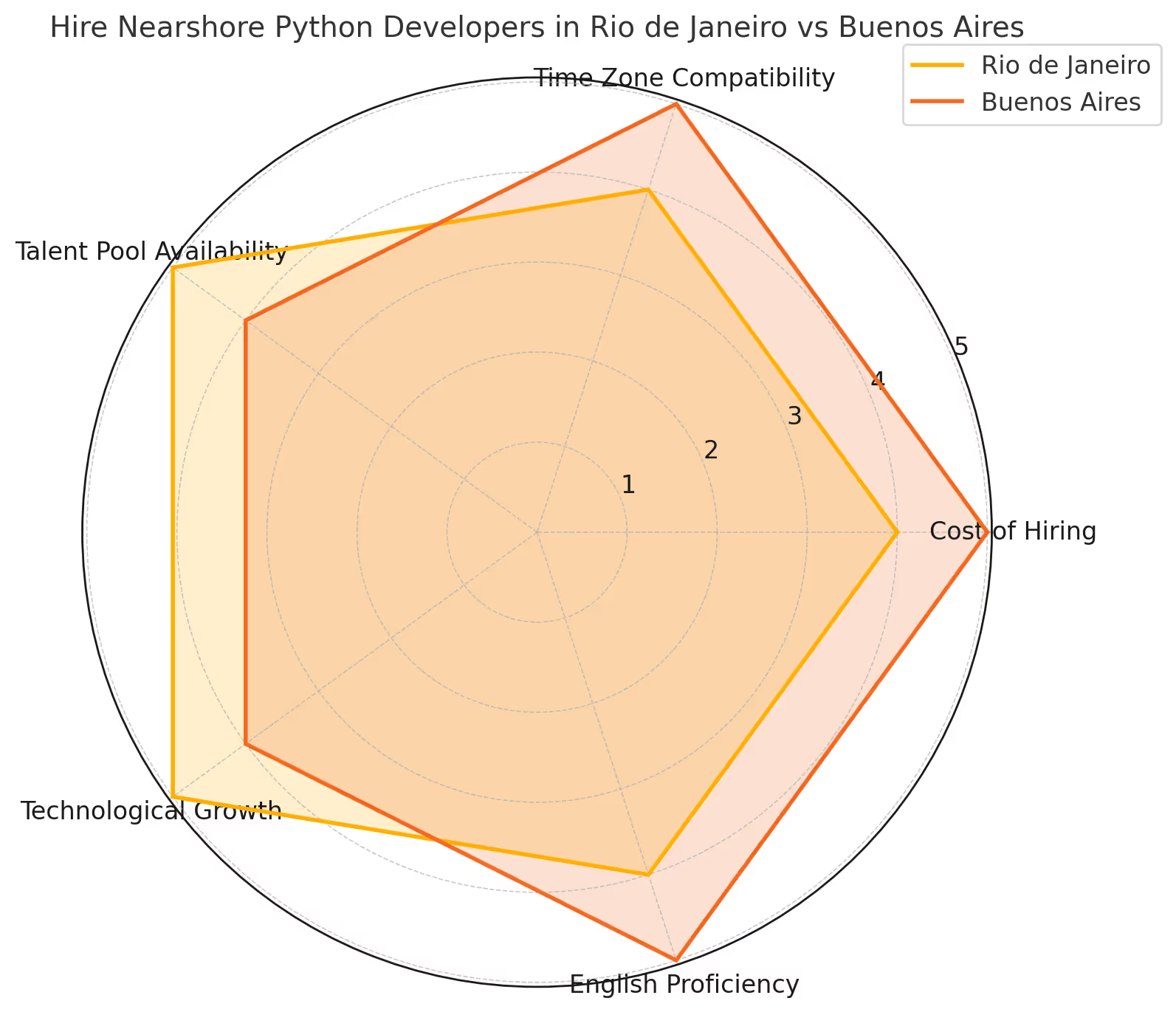Hiring Python developers can significantly impact your tech projects—but finding the right talent at a reasonable cost isn’t always easy. That’s why many companies are turning to nearshore development, especially nearshoring to Latin America.
Rio de Janeiro and Buenos Aires have become two of the most popular destinations to hire nearshore Python developers. Both cities offer skilled professionals, competitive costs, and excellent time zone alignment with the United States.
But which city is the better choice for your business? We’ll walk you through the key factors, like costs, time zone compatibility, and technical skills, to help you make an informed decision.
Learn more about nearshore staff augmentation to scale your team with agility.
Hire Nearshore Python Developers in Rio de Janeiro vs Buenos Aires
When looking to hire nearshore Python developers, two standout locations in Latin America are Rio de Janeiro and Buenos Aires. Both cities offer skilled talent, cost-effective hiring, and strong time zone alignment with U.S. companies. The radar chart below compares these key factors to help you determine the best location for your development needs.

Next, we’ll compare cost, talent availability, time zone compatibility, technical expertise, and language proficiency to help you Hire Nearshore Python Developers in the best location.
Cost Comparison
Cost is often the first factor companies consider when deciding where to hire nearshore Python developers. Rio de Janeiro and Buenos Aires offer cost savings compared to U.S. developers, but there are some differences to consider.
Rio de Janeiro: In Rio de Janeiro, the average monthly salary for a Python developer ranges from $3,000 to $5,000, while senior developers are paid from $4,800 to as much as $7,500.
Buenos Aires: In Buenos Aires, salaries tend to be slightly lower. Junior developers typically earn between $2,500 and $5,000 per year, while senior-level professionals earn between $4,250 and $5,750.
Find out more about nearshore software development: The Complete Guide.
Time Zone Compatibility for US Companies
Hire Nearshore Python Developers offers a significant time zone advantage because working in the same or a similar time zone facilitates real-time collaboration, eliminates communication delays, and allows for faster meetings and updates. According to research by Prithwiraj Choudhury, people who can work from anywhere experience a 4.4 percent increase in productivity.
Rio de Janeiro: Rio de Janeiro operates on GMT-3, which puts it one hour ahead of Miami (EST) for most of the year. However, during Daylight Saving Time, the time difference increases to two hours. This minimal time difference ensures that teams in Miami can easily collaborate with developers in Rio without the frustration of asynchronous communication. For companies on the West Coast, such as San Francisco (PST), Rio is four hours ahead.
Buenos Aires: Buenos Aires is also on GMT-3, but unlike Rio, Argentina does not observe daylight saving time, so Buenos Aires is always one hour ahead of Miami throughout the year. For teams based in San Francisco, Buenos Aires is also four hours ahead.

Talent Pool Availability
Both Rio de Janeiro and Buenos Aires have impressive pools of Python talent, supported by strong educational foundations and active technology communities.
Rio de Janeiro: The Universidade Federal do Rio de Janeiro (UFRJ) is ranked 8th in the QS Latin America University Rankings, highlighting its key role in educating highly skilled professionals for the ecosystem. As the largest federal university in Brazil, UFRJ is recognized for its excellence in teaching and research. It is estimated that more than 630,000 software engineers work in the IT services sector in Brazil, of which approximately 133,000 specialize in software development.
Buenos Aires: Buenos Aires is home to some of the most prestigious universities in Latin America, including UBA, which is ranked 71st in the QS Latin America University Rankings with an overall score of 67.6. Internationally recognized for its excellence in science and engineering, UBA is an educational reference in the region. In addition, the city has a high level of English proficiency, making it a growing center for technology outsourcing. With approximately 115,000 professionals in the sector, Argentina is positioned as a key outsourcing destination.
Technological growth
Rio de Janeiro and Buenos Aires are two of the most important cities in Latin America, driven by an ever-growing ecosystem and support from strategic initiatives. Below, we explore the startup landscape in these two cities, highlighting their impact on the region and their potential for the future.
Rio de Janeiro: The city is home to 216 startups, representing approximately 7% of Brazil's startups, and is positioned as the third-best startup ecosystem in the country. In addition, there are initiatives to support the development of the technology scene, such as the launch of Instituto 12, a private initiative supported by companies such as TIM, PRIO, and Hashdex, with infrastructure support from InvestRio.
Buenos Aires: The city has become one of the most important fintech ecosystems in the country and the fifth most important in Latin America. Companies like TurismoCity continue to scale, while unicorns like Ualá have emerged. In addition, Argentina is home to 343 fintech startups that have collectively raised nearly $1 billion in funding. Ualá, the Buenos Aires-based fintech unicorn, launched the country's first commission-free credit card.
English Proficiency
Both cities have a growing number of Python developers with a solid command of English. However, when it comes to English fluency, Buenos Aires has a clear advantage, making it an excellent choice to hire nearshore Python developers with strong communication skills.
Rio de Janeiro: Brazil, on the other hand, ranks 81st globally, with Rio de Janeiro scoring 500 on the English Proficiency Index. Although Rio de Janeiro developers who have worked with international clients tend to speak English well, the overall level of proficiency is generally lower than in Buenos Aires.
Buenos Aires: Argentina ranks among the top Latin American countries in English proficiency, ranking 28th globally out of 116 countries. Buenos Aires, in particular, scores 566 on the English Proficiency Index, making it one of the most English-proficient cities in the region. Many Buenos Aires developers are comfortable participating in client meetings, communicating technical concepts clearly, and collaborating seamlessly with U.S.-based teams.
Teilur Talent’s Transparent Pricing for Nearshore Developers
Teilur Talent is disrupting the international recruiting industry through a revolutionary approach to pricing. When you hire nearshore Python developers with Teilur Talent, you benefit from a transparent pricing model that sets us apart from traditional staffing firms. Unlike many competitors, we disclose our margins upfront—ensuring they never exceed 20% of the payment you make to candidates. This level of transparency gives clients clarity on costs from day one, eliminating the guesswork typically associated with outsourcing.
Potential clients can see expected salary ranges directly on our website, providing full visibility into what they’ll pay and what developers will earn. This open approach not only fosters trust but also simplifies the hiring process, allowing businesses to make informed decisions without hidden fees or surprises. By offering a clear, fair pricing structure, Teilur Talent empowers companies to hire nearshore Python developers with confidence—knowing they’re partnering with a team that prioritizes honesty and long-term success.
Learn more about Teilur Talent's pricing disruption with transparency in recruiting.
FAQ
How much does nearshoring cost?
Nearshoring costs vary based on location, developer experience, and project requirements. For example, hiring a senior Python developer in Buenos Aires may cost around $4,250 to $5,750 per month, while in Rio de Janeiro, the range is closer to $4,800 to $7,500 monthly.
What is nearshore development?
Nearshore development involves outsourcing software development to neighboring countries with similar time zones. Hiring developers from Latin America is a popular nearshoring strategy for US companies.
What is an example of nearshore?
An example of nearshoring would be a tech company in California hiring Python developers in Buenos Aires to collaborate in real-time during overlapping business hours.
Where can I hire a Python developer?
You can hire Python developers through talent marketplaces, recruitment agencies, or by partnering with a nearshore talent provider specializing in Latin American tech talent.
Conclusion
Whether to hire nearshore Python developers in Rio de Janeiro or Buenos Aires depends on your company's specific needs and priorities. Both cities offer a talented workforce, competitive costs, and substantial time zone alignment with the U.S., making them excellent choices for nearshore development.
Buenos Aires has a slight edge if cost efficiency and strong English language skills are top priorities. Argentina's lower salary ranges and high English proficiency make it an attractive destination for companies that need seamless communication with their development teams. On the other hand, if you're looking for developers with enterprise-level experience in industries like fintech and data science, Rio de Janeiro offers a deep talent pool with strong technical expertise.
To help you make the best decision, use the calculator below to estimate your costs and potential savings. For more details and personalized advice, please contact us.








